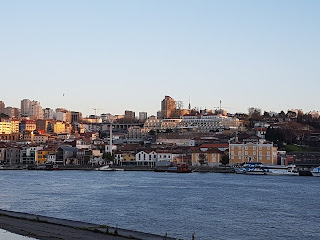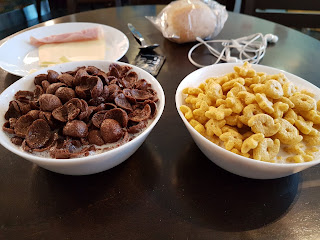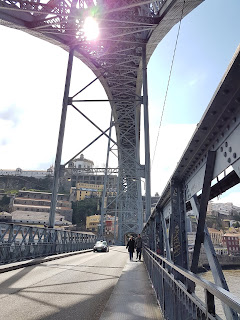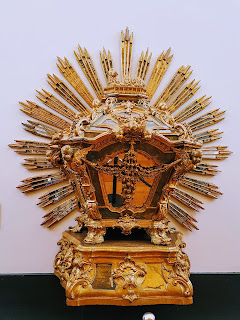Photos 19th March 2018. Porto
Sunny Monday morning. It is the right place for a relaxing walk...
The prestigious wines of Oporto inside the supermarket Continente
The cat of the supermarket sleeping in the cafeteria
Nostalgic trams... Currently, only about a dozen vintage trams run down the three remaining tram lines in Porto. A great way of discovering this captivating city
Old yet renovated building with the typical Porto architecture
The wine I bought for my mom: Port wine Ferreira Tawny
Sunset in front of the river...
From this side we see Vila Nova de Gaia, where all the Port Wine cellars are located. Ferreira Port Wine was created in 1751 by a Portuguese family of wine-markers. Antónia Adelaide Ferreira, the responsible for the brand, quickly became a symbol of strength against the adversities of being twice widowed and a woman at the front of a company in the 18th century. Antónia Adelaide was kindly called Ferreirinha, a name which stuck to her brand through the years
The wine lodges of Vila Nova de Gaia offer tours and tastings (in English). Wine lodges in the area include such names as Barros, Cálem, Cockburn, Croft, Ferreira, Graham's, Kopke, Osbourne, Ramos Pinto, Sandeman, and Taylor, Fladgate and Yeatman
Facades of the old houses in the district of Ribera
In the distance, Arrabida Bridge
The sunsets at this old part of the city are absolutely enchanting... A delightful place
Photos 20th March 2018. Porto
Free breakfast buffet for all our guests... For a great start to the day, there is nothing like a great breakfast with cereals, bread, cheese, ham, milk, butter, etc. Though Estrelinhas cereals were mine. I bought them in Continente... I love them xD
A display of colourful ceramic tiles sold as tourist souvenirs... and souvenir refrigerator magnets decorated as traditional white and blue Portuguese azulejo tiles...
More fridge magnets outside the souvenir shop...
Robin Ruth Porto caps
Tourist boats tour in the Douro river
The Dom Luís I Bridge
Spectacular views overlooking the Douro river and the historic center of Porto, Ribeira
Pictures taken from Vila Nova de Gaia on the opposite side of river Douro
Behind Cálem cellar...
A great way to see the Port wine area in Vila Nova de Gaia is to take
the cable car from the top of the town down to Cais de Gaia, on the river bank
The Teleférico de Gaia was built between March 2009 and April 2011. The upper station puts you close to the Metro station, where you can either take a tram across the river to the historic sites of Porto city centre, or you can walk across the bridge for some breathtaking photo opportunities...
A lovely seagull in Vila Nova de Gaia...
View of the quarter of Ribeira
View to Porto, over the roofs of wine cellars
Abandoned building in the center
Rampa do Infante Santo leads to the Monastery: Mosteiro da Serra do Pilar
We didn't visit the monastery itself, but hung out on the terrace overlooking the city...
Mosteiro da Nossa Serra do Pilar - Serra do Pilar Monastery
This monastery is situated on the top of the mountain range of the same name, the Serra do Pilar, in Vila Nova de Gaia. Built in a circular shape typical of the Rennaissance, with a hemispheric vault surrounded by a narrow balcony, and circular cloisters with 36 ionic columns – the only example in Portugal – the Serra do Pilar Monastery is a World Heritage site since 1996. This monastery was opened to the public in December 2012 as a northern Heritage building. Here, one can see films made of the four locations listed as UNESCO World Heritage sites (the historic centres of Porto and Guimarães, the highlands of the Alto Douro wine-producing region and the Foz Côa Arqueological Park). Here, you will also find a statue of the first king of Portugal, D. Afonso Henriques, and there are also guided tours conducted by an element of the army stationed here, that owns most part of this site
View from the Mosteiro da Nossa Serra do Pilar across the Douro to Porto
Metro unit crossing the Ponte Dom Luís I from Gaia to Porto
Steps leading down to the River Douro waterfront in the Ribeira district of Porto. A staircase alongside segment of the fortifications
A church of Barroque design buit in the XVIII century. This church was first established in Rua Escura, near the old prisons, and was eventualy occupied by the iron convent. The convent took is name from the iron bolt that crossed the door of the primitive church. Acording to tradition any prisoner lucky enough to reach the bolt was saved from dead
Infante D. Henrique Bridge, a road bridge, deck-stiffened arch bridge
and prestressed concrete bridge that was built from 1999 until 2002
The Dom Luís I Bridge
Monumental fountain (Fonte da Ribeira) with a St John the Baptist statue on Ribeira Square (Praça da Ribeira). It was built in the 1780s and decorated with the coat-of-arms of Portugal. The niche of the fountain is occupied by a modern statue of St John the Baptist by sculptor João Cutileiro
Nowadays the Ribeira Square is a favourite spot for tourists...
The sightseeing bus... an excellent way of seeing the sights
São João street
Close to the Ribeira and connecting the river to Rua dos Mercadores, you’ll find one of the most important, culturally relevant and famous streets in Porto. Named after Saint John, the street is one of those streets that come to life around June 23rd, where São João festival celebrations take place.
The street was designed by João Almada e Melo, the Marquês de Pombal of Porto. His design had an Italian influence. You can also see the unique 18th century Portuguese architecture called Pombaline style where windows are all on the same level, even the ones with balconies
The street was designed by João Almada e Melo, the Marquês de Pombal of Porto. His design had an Italian influence. You can also see the unique 18th century Portuguese architecture called Pombaline style where windows are all on the same level, even the ones with balconies
Largo São Domingos. Largo do São Domingos connects many famous streets in Porto from different eras: medieval (Rua dos Mercadores), 16th century (Rua das Flores) and 19th century (Rua Mouzinho da Silveira). The name comes from the São Domingos Monastery which was there before the Largo do São Domingos was built.
This street was built to answer the questions of accessibility and connection. The street made it possible to go north or to Torre dos Clérigos. It also connects to Ribeira
This street was built to answer the questions of accessibility and connection. The street made it possible to go north or to Torre dos Clérigos. It also connects to Ribeira
The Baroque Church of Mercy of Porto (Igreja da Misericordia) is located on Rua das Flores, a street very popular visited by many tourists... Rua das Flores extends from São Bento station all the way to Palácio das Artes museum on Largo do São Domingos. The name of the street literally means Flowers’ Street because the land it was built on had plantations of flowers and some vegetables.
The street used to connect many religious buildings like the 1521 Igreja da Misericórdia, the 1245 São Domingos Convent (now it’s Palácio das Artes) and the 1518 Avé-Maria de São Bento Convent (it doesn’t exist anymore, São Bento Railway Station was built in its place)
The street used to connect many religious buildings like the 1521 Igreja da Misericórdia, the 1245 São Domingos Convent (now it’s Palácio das Artes) and the 1518 Avé-Maria de São Bento Convent (it doesn’t exist anymore, São Bento Railway Station was built in its place)
An old building on Almada Street, in downtown Porto. This street crosses the city centre in several points of interest and is full of commercial shops but also there're a lot of abandoned buildings. It's parallel to the famous Aliados
Hard Rock Cafe Porto near the vibrant Avenida dos Aliados,
located in a high-personality 19th century building
José Duarte Ramalho Ortigão statue; work by Leopoldo de Almeida, dated from 1953 and inaugurated in 1954. It is placed in Cordoaria Garden. The Cordoaria Garden is located in the vicinity of some of the top attractions of Porto, such as the Clerigos Tower (and the adjoining church), the Portuguese Center of Photography and the historical Santo Antonio Hospital. The official name of the venue is the Joao Chagas Garden, but locals commonly refer to it as the Cordoaria Garden
Giant blue letters spelling "Porto"... in three dimensions which you can sit on and pose for an obligatory photo! They are located in the main square of the city near the town hall...
We went to Clérigos Tower or the Torre dos Clérigos, one of the most famous sites in Porto and a priority on my list... One of the main attractions... This bell tower can be seen from just about everywhere in the city... The Clérigos museum is extensive and full of many sculptures, paintings, furniture, goldsmithery and the "Christus Collection" of various artistic and devotional depictions of Christ on the Cross.
Many of these museum pieces were private, some from personal collections
and most used in the daily life and worship of the Brothers of the Clerics...
The Sanctuary. Main altar of marble and Rococo style
Our Lady of the Assumption
The tower is 225 steps up, and 75 meters high. It is worth the climb
as the views are absolutely stunning as you can see below... I took many pics
Awesome views of the city from the Clérigos Tower
View Southeast of the Cathedral
We enjoyed the climb and the view from the top of the tower
Small catwalk on the Top of the Clérigos Tower
Touch Screen Display to explore the tower
Old stone stairs along medieval wall
More pics of the Douro River
Ribeira do Porto - Ribeira Square















































































































































































































.jpg)

No comments:
Post a Comment